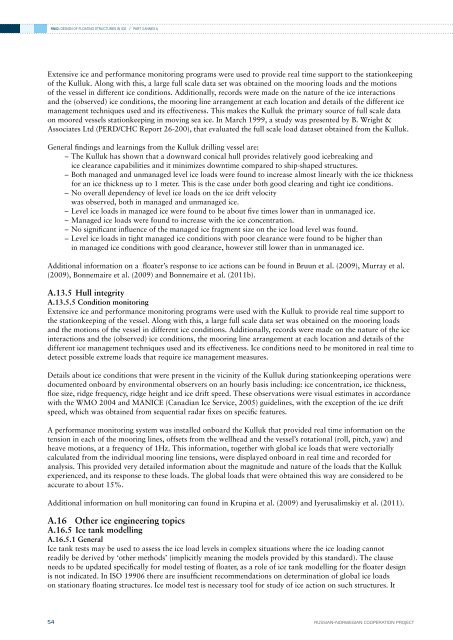phase 4 report - DNV
phase 4 report - DNV
phase 4 report - DNV
Create successful ePaper yourself
Turn your PDF publications into a flip-book with our unique Google optimized e-Paper software.
RN02: DESIGN OF FLOATING STRUCTURES IN ICE // PART 3 ANNEX AExtensive ice and performance monitoring programs were used to provide real time support to the stationkeepingof the Kulluk. Along with this, a large full scale data set was obtained on the mooring loads and the motionsof the vessel in different ice conditions. Additionally, records were made on the nature of the ice interactionsand the (observed) ice conditions, the mooring line arrangement at each location and details of the different icemanagement techniques used and its effectiveness. This makes the Kulluk the primary source of full scale dataon moored vessels stationkeeping in moving sea ice. In March 1999, a study was presented by B. Wright &Associates Ltd (PERD/CHC Report 26-200), that evaluated the full scale load dataset obtained from the Kulluk.General findings and learnings from the Kulluk drilling vessel are:––The Kulluk has shown that a downward conical hull provides relatively good icebreaking andice clearance capabilities and it minimizes downtime compared to ship-shaped structures.––Both managed and unmanaged level ice loads were found to increase almost linearly with the ice thicknessfor an ice thickness up to 1 meter. This is the case under both good clearing and tight ice conditions.––No overall dependency of level ice loads on the ice drift velocitywas observed, both in managed and unmanaged ice.––Level ice loads in managed ice were found to be about five times lower than in unmanaged ice.––Managed ice loads were found to increase with the ice concentration.––No significant influence of the managed ice fragment size on the ice load level was found.––Level ice loads in tight managed ice conditions with poor clearance were found to be higher thanin managed ice conditions with good clearance, however still lower than in unmanaged ice.Additional information on a floater’s response to ice actions can be found in Bruun et al. (2009), Murray et al.(2009), Bonnemaire et al. (2009) and Bonnemaire et al. (2011b).A.13.5 Hull integrityA.13.5.5 Condition monitoringExtensive ice and performance monitoring programs were used with the Kulluk to provide real time support tothe stationkeeping of the vessel. Along with this, a large full scale data set was obtained on the mooring loadsand the motions of the vessel in different ice conditions. Additionally, records were made on the nature of the iceinteractions and the (observed) ice conditions, the mooring line arrangement at each location and details of thedifferent ice management techniques used and its effectiveness. Ice conditions need to be monitored in real time todetect possible extreme loads that require ice management measures.Details about ice conditions that were present in the vicinity of the Kulluk during stationkeeping operations weredocumented onboard by environmental observers on an hourly basis including: ice concentration, ice thickness,floe size, ridge frequency, ridge height and ice drift speed. These observations were visual estimates in accordancewith the WMO 2004 and MANICE (Canadian Ice Service, 2005) guidelines, with the exception of the ice driftspeed, which was obtained from sequential radar fixes on specific features.A performance monitoring system was installed onboard the Kulluk that provided real time information on thetension in each of the mooring lines, offsets from the wellhead and the vessel’s rotational (roll, pitch, yaw) andheave motions, at a frequency of 1Hz. This information, together with global ice loads that were vectoriallycalculated from the individual mooring line tensions, were displayed onboard in real time and recorded foranalysis. This provided very detailed information about the magnitude and nature of the loads that the Kullukexperienced, and its response to these loads. The global loads that were obtained this way are considered to beaccurate to about 15%.Additional information on hull monitoring can found in Krupina et al. (2009) and Iyerusalimskiy et al. (2011).A.16 Other ice engineering topicsA.16.5 Ice tank modellingA.16.5.1 GeneralIce tank tests may be used to assess the ice load levels in complex situations where the ice loading cannotreadily be derived by ‘other methods’ (implicitly meaning the models provided by this standard). The clauseneeds to be updated specifically for model testing of floater, as a role of ice tank modelling for the floater designis not indicated. In ISO 19906 there are insufficient recommendations on determination of global ice loadson stationary floating structures. Ice model test is necessary tool for study of ice action on such structures. It54RUSSIAN–NORWEGIAN COOPERATION PROJECT






![Risk Based Pipeline Integrity Management [Compatibility Mode] - DNV](https://img.yumpu.com/50424229/1/190x146/risk-based-pipeline-integrity-management-compatibility-mode-dnv.jpg?quality=85)









